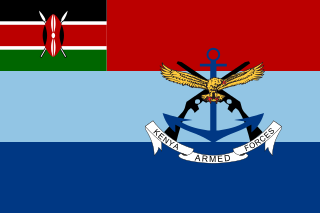
The Kenya Defence Forces (KDF) are the armed forces of the Republic of Kenya. They are made up of the Kenya Army, Kenya Navy, and Kenya Air Force. The current KDF was established, and its composition stipulated, in Article 241 of the 2010 Constitution of Kenya; it is governed by the KDF Act of 2012. Its main mission is the defence and protection of the sovereignty and territorial integrity of Kenya, recruitment to the KDF is done on yearly basis. The President of Kenya is the commander-in-chief of the KDF, and the Chief of Defence Forces is the highest-ranking military officer, and the principal military adviser to the President of Kenya.

The Somali Armed Forces are the military forces of the Federal Republic of Somalia. Headed by the president as commander-in-chief, they are constitutionally mandated to ensure the nation's sovereignty, independence and territorial integrity.

The Isaaq is a major Somali clan family. It is one of the largest Somali clan families in the Horn of Africa, with a large and densely populated traditional territory.

The Hawiye is the largest Somali clan family. Members of this clan traditionally inhabit central and southern Somalia, Somaliland, Djibouti, Ethiopia and Kenya. They are also the majority in the capital city, Mogadishu.
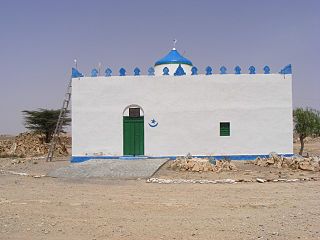
The Darod is a Somali clan. The forefather of this clan was Sheikh Abdirahman bin Isma'il al-Jabarti, more commonly known as Darod. The clan primarily settles the apex of the Horn of Africa and its peripheries, the Somali hinterlands adjacent to Oromia (Ogaden), and both sides of the Kenya–Somalia border. The Darod clan is the largest Somali clan family in the Horn of Africa.
The United Somali Congress (USC) was one of the major rebel organizations in Somalia. Formed in 1989, it played a leading role in the ouster of the government of Siad Barre in 1991, and became a target of the Unified Task Force campaign in 1993. Following infighting, the USC later splintered into smaller groups. By 2000, with the establishment of a Transitional National Government (TNG), a process of disarmament was put in motion and some moderate ex-USC leaders were incorporated into the new interim administration.
The Egyptian Military College is the oldest and most prominent military academy in Egypt. One of the colleges of the Egyptian Military Academy Traditionally, graduates of the Military Academy are commissioned as officers in the Egyptian Army. However, they may serve in other branches and commands of the Egyptian military establishment.

The Somaliland National Armed Forces are the military services of the Republic of Somaliland. The Somaliland National Armed Forces consist of the Somaliland National Army, the Somaliland Coast Guard, the Somaliland Police Force, the Somaliland Custodial Corps, the Somaliland Immigration and Border Control and the Somaliland Fire Brigade. There is no air force. The Armed Forces is under the command of President Muse Bihi Abdi, who is the Commander-in-chief. Minister of Defence Abdiqani Mohamoud Aateye is the designated minister that oversees the armed forces.
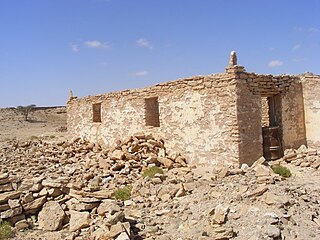
Harti, meaning "strong man", is a Somali clan confederation, part of the larger Darod clan. The major sub-clans include the Majeerteen, Warsangeli, Dishiishe and Dhulbahante while the minor sub-clans consist of Kaskiqabe, Geesaguule and Liibaangashe.
Abgaal is a sub-clan of the Hawiye and the even larger Samaale clan. It is one of the major Somali clans and has produced many prominent historical Somali figures including 3 presidents, and the father of the Somali military.
General Ismail Qasim Naji in Borama, Somalia was the chief of staff of the Transitional Federal Government (TFG) of Somalia and currently the Somali ambassador in Oman. He has served as a senior officer of the Somali army since the administration of Siad Barre, who was removed from power in 1991. Before the formation of the TFG, he also commanded the army of the predecessor Transitional National Government (TNG) of Somalia between 2002 and 2004.

The Ministry of Defence is charged with co-ordinating and supervising all agencies and functions of the government relating directly to national security and the Somali Armed Forces. The President of Somalia is the Supreme Commander of the Armed Forces of the country. The Ministry of Defence provides policy framework and resources to the Armed Forces to discharge their responsibility in the context of the defence of the country. The Armed Forces under the Defence Ministry are primarily responsible for ensuring the territorial integrity of the nation. The current Minister of Defence of Somalia is Abdulkadir Mohamed Nur.
The Shifta War or Gaf Daba (1963–1967) was a secessionist conflict in which ethnic Somalis in the Northern Frontier District (NFD) of Kenya attempted to join Somalia. The Kenyan government named the conflict "shifta", after the Swahili word for "bandit", as part of a propaganda effort. The Kenyan counter-insurgency General Service Units forced civilians into "protected villages" as well as killing livestock kept by the pastoralist Somalis.
The Hiraab is a Somali clan of the larger Hawiye. It has produced many major clans in Somalia and has produced many prominent figures including 6 presidents, the first president as well as the first PM. They were also the first military leaders, making Hiraab the forefounder of Somalia. Members live in central and southern Somalia, from Galkayo to Kismaayo. They are also present in Ethiopia and Kenya. Most of them live in Mogadishu.

The Supreme Council of the Armed Forces is a statutory body of between 20 and 25 senior officers of the Egyptian Armed Forces, and is headed by Field Marshal Abdel Fattah al-Sisi and Lieutenant General Mohamed Ahmed Zaki. The council is convened only in cases of war or great internal emergencies.
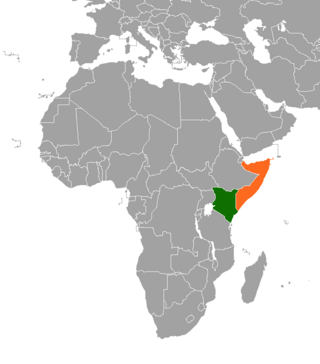
The Somali–Kenyan conflict has been an issue within Kenya since the colonial period. Problems have ranged from skirmishes between the two communities and have led to terrorist attacks, police harassment, extortion, home invasions, physical violence, and massacres perpetrated against Somalis and Kenyans.

General Abdulkadir Sheikh Dini is a Somali politician and military official. He served as Chief of Army from March 2011 to March 2013, under both the Transitional Federal Government and the succeeding Federal Government of Somalia. He is a former Minister of Defense of Somalia after being succeeded by Abdirashid Abdullahi Mohamed.
Hussein Maalim Mohamed is a Kenyan politician. He is a former Minister of State in the office of the president.
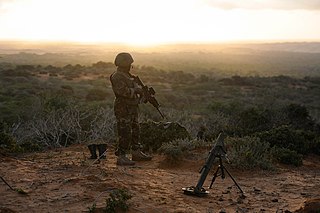
Operation Indian Ocean was a joint military operation between the Somali military, AMISOM and the United States military against the Al-Shabaab militant group aimed at eliminating the remaining insurgent-held areas in southern Somalia. It officially began in August 2014.











